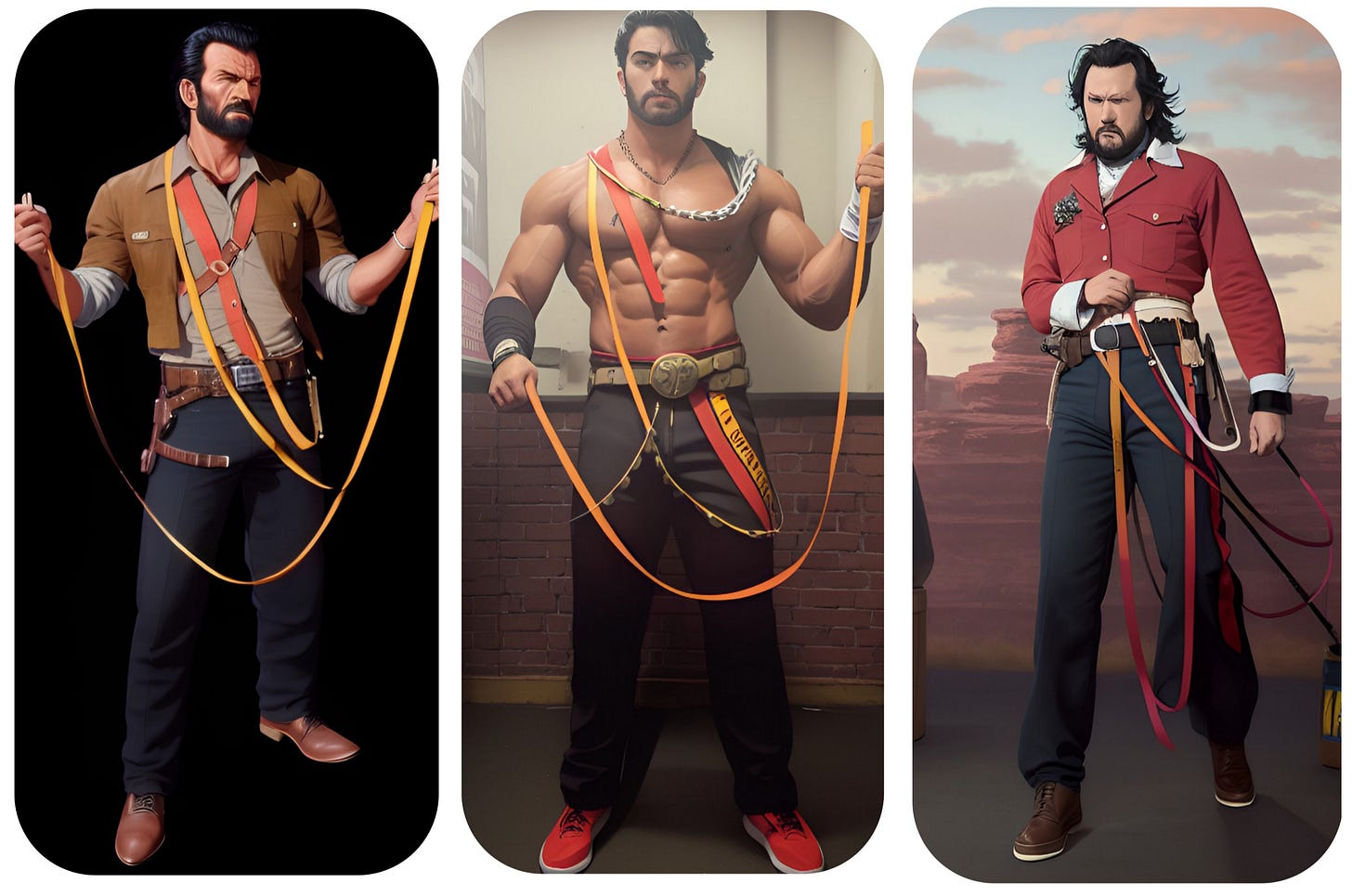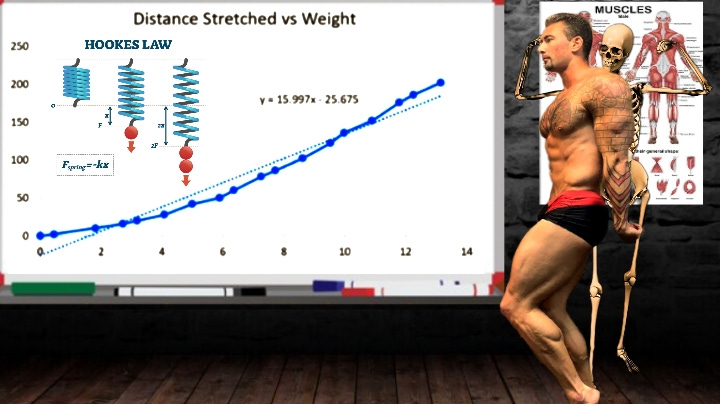Though training with bands has become very popular, there appears to be a lack of fundamental knowledge in the usefulness and application of this method.
For example, how they affect force production, and whether or not they can improve maximal strength in untrained and trained individuals.
In many cases, band training is used to improve an athlete’s ability to overcome the “sticking point” of a lift or to increase the force production in the latter stages of the exercise (i.e. The end ranges of motion).
Resistance bands are customarily measured for weight resistance level by the manufacturer using their preferred type of scale.
The band is anchored to the scale, stretched, and a reading is taken at the beginning of the pull, then again at the farthest safe distance from the anchor point. An average is then calculated from both readings and is used to decide the equivalent pounds of resistance.
For convenience, most resistance band manufacturers will abide by a common system of colors to help people conveniently identify the different tension levels, from easiest to heavy duty.
Resistance bands fall into 2 main types:
Flat sheets with no handles. And Rubber tubing that may or may not have handles of some sort attached to them.
Each of the 2 types of resistance bands has different design options that make one or another better for some kinds of training.
Flat sheet resistance bands
Flat resistance bands can be long sheets of rubber that are gripped by the fingers, or wrapped around the hand when used. These types of bands are usually used in physical therapy to rehabilitate certain injuries.
Flat resistance bands that are made into loops, also have no handles, and are used to perform low resistance/ high repetition exercises for the legs and hips.
Tube resistance bands are used more appropriately for conventional bodybuilding and strength training. There is a wide range of different configurations available with the sturdier tube band.
Rubber tubing resistance bands with handles attached.
The traditional tube resistance band has handles permanently attached to them. To vary your level of exertion you need to buy multiple resistance bands.
Tube resistance bands also come in different configurations that are specific for certain types of training.
Bow-tie resistance bands
There is the bow-tie design, then there are tube resistance bands that are no more than a foot or so long and have Velcro ankle cuffs.
These are specifically for lower body training and work the hip, outer and inner thighs and can be used, like the bowtie and hoop designs, to do super effective walk and lunge training
.
So how effective are they for hypertrophy?
As you all know the process of muscle growth is known as hypertrophy.
There are three main mechanisms for hypertrophy: mechanical tension, muscle damage, and metabolic stress.
Mechanical tension is the process of loading the muscle in some way and creating tension.
And Resistance bands certainly offer a form of mechanical tension.
Out of the three mechanisms for muscle growth, mechanical tension is by far the most well-established and clearly the biggest contributor.
With bands the resistance is not caused by the force of gravity as we see with free weights, but they do offer a mechanism for loading our muscles through the elastic properties of the band.
When you lift a dumbbell, kettlebell, etc, the movement is resisted by the weight of the object. (The weight of the object is the mass m times the acceleration of gravity g).
In contrast, the same motion performed with a resistance band is resisted by the tension or T of the band. What is that tension?
The tension is a function of the amount of length that the band is stretched, described by Hooke’s Law.
In math terms, that means that the tension T = -kx.
Here, x is the distance that the band is stretched past its relaxation length, or the length of the band with no tension on it.
Here, k is the spring constant of the band. K is determined by the properties of the band materials. Typically, resistance bands are made from latex rubber.
So, I put some of my bands to the test. I hung each band over my scale with weights attached to the ends.
I then placed different weights in the ends of the bands measuring how much the band stretched each time.
I then plotted the distance x versus the weight (mg).
So, I increased the weight until almost the max rating of the band and plotted the change in length vs weight.
And…it’s not a straight line! Long story short… Resistance bands do NOT follow Hooke’s Law, except for a small range of weights/tensions
.Instead, the tension follows a curve. So, if you really want to know how your bands function, you should measure it!
What I found was that a weight of 15lbs stretched the band roughly 20% past its rest length. So anytime I want to achieve that resistance, I need to pull that distance.
For a typical move, like this biceps curl, the force I’m exerting is well below the max rated value.
For example, this band is rated to 70 lbs. However, the distance at which I am pulling only corresponds to maybe half that!
This in itself is annoying but doesn’t seem to be a big problem, right? Well, I’m not done yet!
The second mechanism to produce hypertrophy is Muscle damage.
Muscle damage refers to the small muscle fiber tears that sometimes occur when lifting weights.
They are more associated with the eccentric part of lifting-which is when your muscle is lengthening under tension.
However, unlike free weights, resistance bands offer a very different resistance curve which is quite opposite to that which is provided by gravity.
Take the bicep for example, if you were to stand on one end of a band and curl your arm upward reaching full contraction in the muscle.
You can see here the band is offering the greatest resistance at the conclusion of the movement when your muscle is fully contracted or flexed,
At the beginning portion of the movement there will be zero load on the bicep, as you can see gradually increasing throughout the resistance curve until peaking at the conclusion.
Comparing this to free weights and the use of gravity, the resistance curve is such that there is no load on the biceps when at rest.
However, at the beginning of the movement the muscle will be contacting with maximal force due to the muscle being at a mechanical disadvantage.
However, as it passes through the ark of motion nearing full contraction.
the forearm at one point in time will be parallel with the floor and perpendicular to gravity.
at this point the dumbbell is the furthest from the pivot point as is possible meaning it is as long a lever as it can be at this moment or a 100% active lever.
Past this point the resistance curve again diminishes towards the fully contracted position, ending with less load on the bicep in the fully contracted position were it now has mechanical advantage.
Now this does in fact go with the laws of nature and how muscles operate within a correct resistance curve.
Muscle must always begin from an elongated position as well as a mechanically disadvantaged position.
Then passing through a resistance curve of various resistance and concluding with a mechanical advantage and a fully contracted muscle.
This is the proper resistance curve and will yield the best results for muscle growth period.
The problem is that Resistance bands do not offer this correct resistance curve.
Although they do offer a different form of varied load muscle damage is highly correlated to the lowering portion on the rep, as well being in a completely opposite resistance curve then what are muscles have evolved to do.
So that’s a big problem!
Now to be fair having peak tension just before this lowering may provide some benefit to muscle damage.
But again, bands Essentially, provide the most resistance when your muscle is weakest, shortest, and has mechanical advantage!
And zero resistance at the most important part of the movement where muscle fiber are selected and your muscle can generate the most force!
then finally, the third stimulus for hypertrophy is metabolic stress.
Metabolic stress refers to when your muscles get low on energy which leads to the accumulation of things called metabolites.
Metabolic stress is most often seen when you "chase the pump" and perform tons of reps over and over until the muscle is pumped up and exhausted.
It is a physiological process that occurs during exercise in response to low energy that leads to metabolite accumulation such as lactate, phosphate inorganic and ions of hydrogen in muscle cells.
Traditional Resistance training has an important impact on the increase of metabolite accumulation, which influences hormonal release, hypoxia, and cell swelling.
Changes in exercise routines, such as intensity, volume and rest between sets, are determinants for the magnitude of metabolic stress.
Furthermore, different types of training, such as low-intensity resistance training, or blood flow restriction, or high intensity interval training, could be used to maximize metabolic stress during exercise.
During the last decade, blood flow restriction training also known as occlusion training, combined with low-intensity strength training.
(20%-30% of your 1RM), has been shown to increase strength and muscle size among trained/untrained athletes, the injured and the elderly.
This training model requires the use of cuffs that are placed at the proximal ends of the upper arms or thighs reducing blood flow from the muscle.
Thus, the external pressure applied maintains arterial inflow while blocking venous outflow of blood, resulting in an ischemic/hypoxic environment that enhances the training effect.
It is not clear if the maximal degree of muscle hypertrophy can be optimized by increasing external loads or if the ceiling for maximal hypertrophy is achieved with low-moderate loads.
Now the reason I’m bring all this up is because the resistance that Resistance bands provide is…complicated.
Resistance bands will also be loading your muscle exactly opposite the natural strength curve as already previously addressed, although they add benefit the second half of the movement
They are certainly very versatile and useful for certain sports specific training as well as a reduction in body weight loading for certain exercises such as to assist in a modified push up, chin up, step up or any other body weight exercise you could creatively add it too.
Long story short there is no conclusive data on the effect resistance bands have on muscle growth although it certainly seems to me at least that it is very minimal and in some cases can certainly be counterproductive,
Another issue I have is if you're going to be using resistance bands and everyone is always talking about how cheap they are and portable they are.
Why would you not simply make yourself a portable keychain gym and use your knowledge of biomechanics to your advantage?
Ill link a video on how to make one at the end of the video btw its cheap and easy don’t worry.
as you hopefully already know anything can be weight, from your body weight, to water, dirt, rocks, kids, spouses, books etc.
And if you have the correct knowledge and information to apply to your own body you will never have any issue performing the perfect biomechanical exercises for maximum muscle hypertrophy anywhere any time
On a side note, I am very soon going to be conducting a study to test the effectiveness of adding resistance bands to free weights or cables
with the correct biomechanical exercises to see if the previously mentioned qualities of the resistance band will add anything extra to the process of muscle hypertrophy,
Anything from perceived muscle fatigue, to increase his metabolic stress, increasing neurological connection or mind muscle connection with the muscle or perhaps even stabilizing and reducing momentum which would also lead to an increase in hypertrophy.
If anyone is curious who watches this video, please just let me know by email and I will send you all relevant details the study will be taking place within a few months’ time when I have enough participants.
I would also like to give a shout out and thank you to Le cardio the company who sponsored this video and sent me quite a few resistance bands to test out and break in at my leisure.
provided I would give some constructive feedback,
I warned them from the very beginning that I would be holding back no punches and I will strictly be digging into the science behind resistance bands.
And a brief note I would like to say that their bands are pretty amazing
Very consistent in their strength and durability, I quite like the colors as well as the versatility of them.
I tested them extensively over the past two months and only one of the weakest ones broke and that's on me because I wanted to see the actual limits of their capabilities, As well as what happened in the event one was to fail.
I have included band videos you will find helpful, and all of the will be individually added to my exercise library playlist so you can find them at your leisure.
I would also like to remind you all to check out my Esty store where I have all my books as well as many tools available for download.
for just a few dollars if you trust me, please invest in yourself and your knowledge
For the price of a coffee and omelet you can have all the information you could ever need downloaded instantly and good forever and able to share with anyone!
And you will be helping me to make more of these videos! If you want to take a direct hand in supporting this channel, please consider joining 😊 as you receive lots of additional benefits
I hope you found this article helpful and thank you all for watching and subscribing






